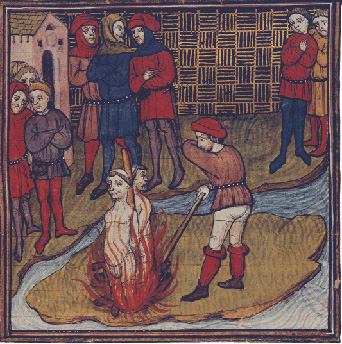Knights Templar History – Fall of the Knights
Once the Muslim world united under a strong leader, the Knights Templar started to lose ground. Saladin was the first strong Muslim leader and was able to lead the Muslim forces to victories against their Christian foes from Europe. In 1187, Saladin’s forces captured Jerusalem and would hold it until 1229 when Christian Crusaders recaptured the city. The victory was short lived as the city fell to the control of the Khwarezmi Turks in 1244. With the Templar Knights retreating, their influence and prestige was also waning back in Europe. So much so that common French phrases included “to drink like a Templar.”
Mission Failed
The Templar Knights were founded to hold the holy lands under Christian control and provide safe passage for pilgrims from Europe. Ultimately, the Knights Templar failed at their mission. Once the pilgrims were no longer able to make their journey, the influence and necessity of the Templars and took a steep decline. Many high ranking nobles had donated land, money, and even their own people to the knights, and they were now looked down upon. In the same token, some nobility had been indebted to the Templars and now saw their opportunity to clear their debt. Of those in debt to the Knights, King Philip IV of France was in substantial debt.
Knights Templar – Accusation and Execution
On October 13, 1307, King Philip ordered the arrest of all Templar Knights. He had accused the Templars of heresy, spitting and urinating on the cross, homosexual practices, and worshiping idols during their secret rituals. At the time, King Philip was heavily in debt to the Templars from his war with England. He pressured the Pope to take action on his accusations. Templars were brutally interrogated and admitted to the charges. The Pope, under pressure from King Philip, ordered the arrest of all Templars and their assets seized. Jacques De Molay, the 23rd and final Grand Master of the Knights Templar, was burned at the stake on March 18, 1314. De Molay was adamant about his innocence and insisted on being tied to the stake so that he may take a posture of humility before the Notre Dame cathedral and pray. With their leadership gone, the assets of the Knights Templar were handed over to the Knights Hospitaller in accordance to a papal decree.
 Knights Templar History – Absolution
Knights Templar History – Absolution
In 2001, a Vatican document called The Chinon Parchment was discovered by Italian Barbara Frale. The Parchment indicates that in 1308 Pope Clement V had absolved the leadership of the Knights Templar, including Jacques De Molay from any charges brought against them. The document was written by a group commissioned by Pope Clement V to investigate the accusations that came from ‘castle Chinon’ in France including sodomy, spitting on the cross, worshiping an idol, denouncing God, and inappropriate kisses. The cardinals conducting the research concluded that the only time Templars were asked to denounce the cross was during initiation. Since some Templars admitted to this act and others didn’t, it is theorized that the practice was meant to prepare Templar Knights in case they were taken prisoner. Furthermore, the document notes that one Templar, Hugo de Perraud, had been told that if he could not resist the lust for women, he was welcome to join with his brothers of the Order. All of the other Templar Knights in the document deny being asked to join with their brothers. The Parchment also details a failed attempt to save the Templars from their fate in France. King Philip carried on with his bloodshed in destroying the Templars, and taking much of their land in the process.
The Vatican published the document in 2007 and presented a copy to Pope Benedict XVI.

